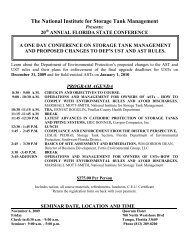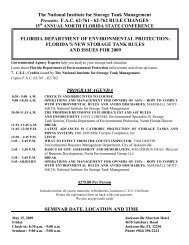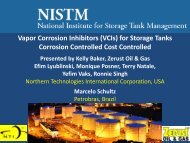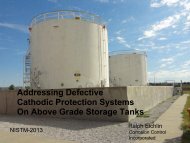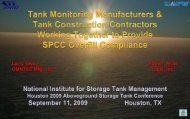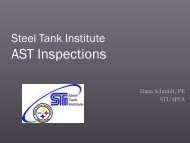Standards
Update to Industry Grounding Standards - NISTM
Update to Industry Grounding Standards - NISTM
- No tags were found...
You also want an ePaper? Increase the reach of your titles
YUMPU automatically turns print PDFs into web optimized ePapers that Google loves.
Update to Industry Grounding<br />
<strong>Standards</strong><br />
David L. Redman<br />
Senior R&D Engineer<br />
Matrix Service Inc.
Outline<br />
• Background on Grounding and Lightning<br />
• API 650 Code Requirements<br />
• NFPA 780 Code<br />
• API RP 2003 Code<br />
• Working Document – API RP 545<br />
09/11/2009 Grounding <strong>Standards</strong> 2
Background<br />
• Metallic structures can have buildup of electrical<br />
energy and can also attract electrical energy<br />
from storms<br />
• Electrical energy always takes the path of least<br />
resistance<br />
• Presentation only addresses bonding<br />
requirements and suggested practices from<br />
applicable codes<br />
09/11/2009 Grounding <strong>Standards</strong> 3
Background (cont’d)<br />
• Concerns with Above Ground Storage Tanks<br />
• Open Top Tanks with Floating Roofs have the largest<br />
risk with fires from lightning strikes<br />
• Sparks can be generated from gaps between seal<br />
shunts and shell<br />
• No other path for electrical energy<br />
• Cone Roof Tanks are generally the safest<br />
• Welded tanks with fixed roofs have very few cases<br />
of fires from lightning strikes<br />
• Biggest risk is with “burn through” from a lightning<br />
strike<br />
09/11/2009 Grounding <strong>Standards</strong> 4
Codes Addressing Bonding for<br />
ASTs<br />
• API 650 – Above Ground Storage Tanks<br />
• NFPA 780 – Standard for Installation of<br />
Lightning Protection Systems<br />
• API RP 2003 – Protection Against<br />
Ignitions Arising Out of Static, Lightning,<br />
and Stray Currents<br />
09/11/2009 Grounding <strong>Standards</strong> 5
API 650 - ASTs<br />
• For ALL Tanks<br />
• Section 5.8.11.3 states that if the Purchaser requires<br />
grounding lugs then it is recommended to provide a<br />
minimum of 4 grounding lugs, equally spaced at a<br />
maximum 100 ft spacing.<br />
• Recently added “…Note: Tanks that rest directly on a<br />
foundation of soil, asphalt or concrete are inherently<br />
grounded for purposes of dissipation of electrostatic<br />
discharges. The addition of grounding rods or similar<br />
devices will not reduce the hazard associated with<br />
electrostatic charges in the stored product.<br />
09/11/2009 Grounding <strong>Standards</strong> 6
API 650 – ASTs (cont’d)<br />
• For Open Top Tanks with Floating Roofs<br />
• Appendix C Section C.3.1.6 states that all<br />
conductive parts shall be grounded and to<br />
provide shunts on the uppermost seal<br />
• Recently added “…All movable cover<br />
accessories (hatches, manholes, pressure<br />
relief devices, and other openings) on the<br />
external floating roof shall be electrically<br />
bonded to the external floating roof to prevent<br />
static electricity sparking when they are<br />
opened”.<br />
09/11/2009 Grounding <strong>Standards</strong> 7
API 650 – ASTs (cont’d)<br />
• For Open Top Tanks with Floating Roofs<br />
• Appendix C Section C.3.7 covers rolling<br />
ladders and it was recently added “…Ladders<br />
shall be grounded to both the roof and the<br />
gauger’s platform with at least an AWG 2/0,<br />
non-tangible cable. Cable shall be configured<br />
so that it will not freeze to adjacent surfaces in<br />
cold weather…”.<br />
09/11/2009 Grounding <strong>Standards</strong> 8
API 650 – ASTs (cont’d)<br />
• For Fixed Cone Roof Tanks with Internal<br />
Floating Roofs<br />
• Appendix H Section H.4.1.6 states that all conductive<br />
parts shall be grounded and to use either shunts or<br />
cable to ground the floating roof to the shell<br />
• Recently added “…The choice of bonding devices<br />
shall be specified by the Purchaser on the Data<br />
Sheet, Line 32, considering strength, corrosion<br />
resistance, joint reliability, flexibility, and service life.<br />
All movable cover accessories (hatches, manholes,<br />
pressure relief devices, and other openings) on the<br />
internal floating roof shall be electrically bonded to<br />
prevent static electricity sparking when they are<br />
opened.<br />
09/11/2009 Grounding <strong>Standards</strong> 9
NFPA 780 – Standard for the<br />
Installation of Lightning Protection<br />
Systems<br />
• Section 7.4.1 – Aboveground Tanks at<br />
Atmospheric Pressure Containing Flammable<br />
Vapors or Liquids That Give Off Flammable<br />
Vapors<br />
• Fixed Roof Tanks<br />
• All joints shall be welded, riveted, or bolted<br />
• All pipes shall be metallically connected at shell<br />
• All vapor openings shall be closed or provided with flame<br />
protection<br />
• Minimum thickness of roof plates is 3/16 inch<br />
• Roof shall be welded, riveted, or bolted to shell<br />
09/11/2009 Grounding <strong>Standards</strong> 10
NFPA 780 – Standard for the<br />
Installation of Lightning Protection<br />
Systems<br />
• Section 7.4.1 – Cont’d<br />
• Floating Roof Tanks<br />
• Seals on Floating Roof (FR) shall be bonded to the shell by<br />
shunts (Type 302, 28 gauge, 2 inch wide stainless steel<br />
straps) at maximum 10 ft spacing<br />
• All Metal Tanks<br />
• All must be grounded by one of the following:<br />
• (1) Tank connected without insulating joints to a grounded<br />
metallic piping system<br />
• (2) Vertical cylindrical tank shall rest on earth or concrete and<br />
shall be at least 20 ft diameter OR rest on bituminous<br />
pavement and shall be at least 50 ft diameter<br />
• (3) Tank shall be bonded to the ground by a minimum of two<br />
grounding electrodes at 100 ft maximum spacing<br />
• (4) Tanks with insulating membrane underneath for<br />
environmental or other reasons shall be grounded as in (3)<br />
09/11/2009 Grounding <strong>Standards</strong> 11
NFPA 780 – Standard for the<br />
Installation of Lightning Protection<br />
Systems<br />
• Section 4.1, Table 4.1.1.1(A)<br />
• Gives minimum cable sizes for grounding<br />
• 17 AWG for copper<br />
• 14 AWG for aluminum<br />
09/11/2009 Grounding <strong>Standards</strong> 12
API RP 2003 – Protection Against<br />
Ignitions Arising Out of Static,<br />
Lightning, and Stray Currents<br />
• Section 4.5 – Storage Tanks<br />
• Recommended Operations<br />
• Restrict flow rate to 3 ft/sec to reduce static buildup<br />
• Keep fill pipe outlet near bottom to avoid splash<br />
filling<br />
• Tanks built on grade-level foundations are<br />
inherently grounded<br />
• Ground all gauging devices and gauge wells<br />
• Mixers and jets should not break the fluid surface<br />
• Floating roof shall be bonded to shell<br />
09/11/2009 Grounding <strong>Standards</strong> 13
API RP 2003 – Protection Against<br />
Ignitions Arising Out of Static,<br />
Lightning, and Stray Currents<br />
• Section 5.4 – Protection of Specific<br />
Equipment Against Lightning<br />
• Section 5.4.2.1 – Fixed Roof Tanks<br />
• All metal parts to be in electrical contact<br />
• Keep all roof openings closed (such as gauge<br />
hatches)<br />
• Ensure fixed roof has adequate thickness (no<br />
holes or excessively thinned areas)<br />
• Use pressure vacuum vents (they provide<br />
backflash from exterior flames)<br />
• Stop tank movements during electrical storms<br />
09/11/2009 Grounding <strong>Standards</strong> 14
API RP 2003 – Protection Against<br />
Ignitions Arising Out of Static,<br />
Lightning, and Stray Currents<br />
• Section 5.4 – Protection of Specific Equipment<br />
Against Lightning<br />
• Section 5.4.2.2 – Open Floating Roof Tanks<br />
• Best protection against ignition are tight seals and properly<br />
designed shunts<br />
• Shunts at maximum 10 ft spacing (2 inches wide X 28 gauge<br />
302 SS material)<br />
• Shunts should have at least 2 inches clearance from top of<br />
shell for positive contact<br />
• Pontoon covers to have mechanical hold downs<br />
• Keep floating roof above landing position (especially during<br />
electrical storms)<br />
09/11/2009 Grounding <strong>Standards</strong> 15
API RP 2003 – Protection Against<br />
Ignitions Arising Out of Static,<br />
Lightning, and Stray Currents<br />
• Section 5.4 – Protection of Specific Equipment<br />
Against Lightning<br />
• Section 5.4.2.3 – Internal Floating Roof Tanks<br />
• Floating roofs shall be electrically bonded to shell<br />
• Shunts at maximum 10 ft spacing (2 inches wide X 28 gauge<br />
302 SS material)<br />
• Shunts should have at least 2 inches clearance from top of<br />
shell for positive contact<br />
• Pontoon covers to have mechanical hold downs<br />
• Keep floating roof above landing position (especially during<br />
electrical storms)<br />
• Provide adequate venting per API 650 Appendix H<br />
09/11/2009 Grounding <strong>Standards</strong> 16
Working Document<br />
API RP 545 – Lightning Protection<br />
for Above Ground Storage Tanks<br />
• Working Document being reviewed by API<br />
Committees<br />
• Main Conclusions from two Phases of testing<br />
• Definite potential ignition hazards at shunt/shell interface for<br />
Open Top Floating Roof tanks.<br />
• Sparking at shunts is inevitable, seal maintenance is<br />
important<br />
• Severity of sparking can be reduced by use of earth cables<br />
from floating roof to shell OR by bonding via rolling ladder<br />
• Immersed shunts may be a good solution to hazardous shunt<br />
sparking<br />
09/11/2009 Grounding <strong>Standards</strong> 17
Working Document<br />
API RP 545 – Lightning Protection<br />
for Above Ground Storage Tanks<br />
• Working Document being reviewed by API<br />
Committees<br />
• Contents of the RP paper – Phase I<br />
• Review of lightning phenomena and the interaction<br />
with above ground storage tanks<br />
• Review of tank base earthing and test current<br />
recommendations<br />
• Lightning tests to shunt/shell samples<br />
• Visit to Oil Refineries A and B<br />
• Review of burn-through and hot-spot effects on<br />
metallic tank skins from lightning strikes<br />
09/11/2009 Grounding <strong>Standards</strong> 18
Working Document<br />
API RP 545 – Lightning Protection<br />
for Above Ground Storage Tanks<br />
• Working Document being reviewed by API<br />
Committees<br />
• Contents of the RP paper – Phase 2<br />
• Lightning simulation testing to determine the<br />
required characteristics for roof bonding cables on<br />
external floating roof above ground storage tanks<br />
• Investigative tests on the lightning protection of<br />
submerged shunts with parallel roof bonding<br />
cables<br />
09/11/2009 Grounding <strong>Standards</strong> 19
Any Questions?<br />
09/11/2009 Grounding <strong>Standards</strong> 20



